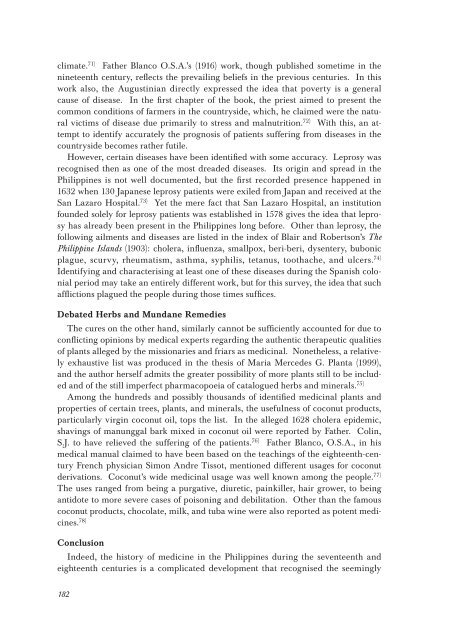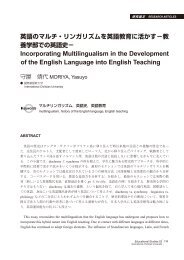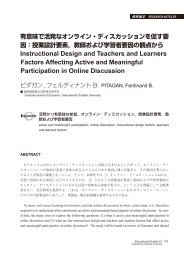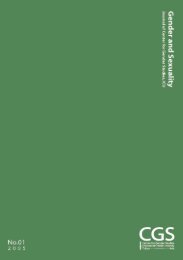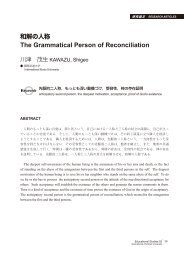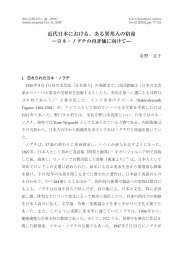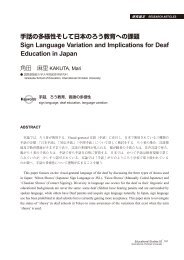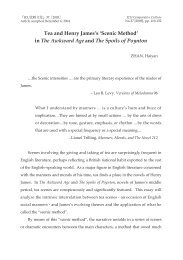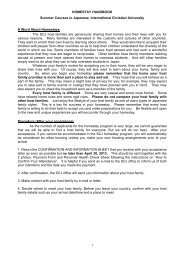Colonial Adaptations in Tropical Asia: Spanish Medicine ... - icu.ac.jp
Colonial Adaptations in Tropical Asia: Spanish Medicine ... - icu.ac.jp
Colonial Adaptations in Tropical Asia: Spanish Medicine ... - icu.ac.jp
You also want an ePaper? Increase the reach of your titles
YUMPU automatically turns print PDFs into web optimized ePapers that Google loves.
climate. 71) Father Blanco O.S.A.’s (1916) work, though published sometime <strong>in</strong> the<br />
n<strong>in</strong>eteenth century, reflects the prevail<strong>in</strong>g beliefs <strong>in</strong> the previous centuries. In this<br />
work also, the August<strong>in</strong>ian directly expressed the idea that poverty is a general<br />
cause of disease. In the first chapter of the book, the priest aimed to present the<br />
common conditions of farmers <strong>in</strong> the countryside, which, he claimed were the natural<br />
victims of disease due primarily to stress and malnutrition. 72) With this, an attempt<br />
to identify accurately the prognosis of patients suffer<strong>in</strong>g from diseases <strong>in</strong> the<br />
countryside becomes rather futile.<br />
However, certa<strong>in</strong> diseases have been identified with some accuracy. Leprosy was<br />
recognised then as one of the most dreaded diseases. Its orig<strong>in</strong> and spread <strong>in</strong> the<br />
Philipp<strong>in</strong>es is not well documented, but the first recorded presence happened <strong>in</strong><br />
1632 when 130 Japanese leprosy patients were exiled from Japan and received at the<br />
San Lazaro Hospital. 73) Yet the mere fact that San Lazaro Hospital, an <strong>in</strong>stitution<br />
founded solely for leprosy patients was established <strong>in</strong> 1578 gives the idea that leprosy<br />
has already been present <strong>in</strong> the Philipp<strong>in</strong>es long before. Other than leprosy, the<br />
follow<strong>in</strong>g ailments and diseases are listed <strong>in</strong> the <strong>in</strong>dex of Blair and Robertson’s The<br />
Philipp<strong>in</strong>e Islands (1903): cholera, <strong>in</strong>fluenza, smallpox, beri-beri, dysentery, bubonic<br />
plague, scurvy, rheumatism, asthma, syphilis, tetanus, toothache, and ulcers. 74)<br />
Identify<strong>in</strong>g and characteris<strong>in</strong>g at least one of these diseases dur<strong>in</strong>g the <strong>Spanish</strong> colonial<br />
period may take an entirely different work, but for this survey, the idea that such<br />
afflictions plagued the people dur<strong>in</strong>g those times suffices.<br />
Debated Herbs and Mundane Remedies<br />
The cures on the other hand, similarly cannot be sufficiently accounted for due to<br />
conflict<strong>in</strong>g op<strong>in</strong>ions by medical experts regard<strong>in</strong>g the authentic therapeutic qualities<br />
of plants alleged by the missionaries and friars as medic<strong>in</strong>al. Nonetheless, a relatively<br />
exhaustive list was produced <strong>in</strong> the thesis of Maria Mercedes G. Planta (1999),<br />
and the author herself admits the greater possibility of more plants still to be <strong>in</strong>cluded<br />
and of the still imperfect pharmacopoeia of catalogued herbs and m<strong>in</strong>erals. 75)<br />
Among the hundreds and possibly thousands of identified medic<strong>in</strong>al plants and<br />
properties of certa<strong>in</strong> trees, plants, and m<strong>in</strong>erals, the usefulness of coconut products,<br />
particularly virg<strong>in</strong> coconut oil, tops the list. In the alleged 1628 cholera epidemic,<br />
shav<strong>in</strong>gs of manunggal bark mixed <strong>in</strong> coconut oil were reported by Father. Col<strong>in</strong>,<br />
S.J. to have relieved the suffer<strong>in</strong>g of the patients. 76) Father Blanco, O.S.A., <strong>in</strong> his<br />
medical manual claimed to have been based on the teach<strong>in</strong>gs of the eighteenth-century<br />
French physician Simon Andre Tissot, mentioned different usages for coconut<br />
derivations. Coconut’s wide medic<strong>in</strong>al usage was well known among the people. 77)<br />
The uses ranged from be<strong>in</strong>g a purgative, diuretic, pa<strong>in</strong>killer, hair grower, to be<strong>in</strong>g<br />
antidote to more severe cases of poison<strong>in</strong>g and debilitation. Other than the famous<br />
coconut products, chocolate, milk, and tuba w<strong>in</strong>e were also reported as potent medic<strong>in</strong>es.<br />
78)<br />
Conclusion<br />
Indeed, the history of medic<strong>in</strong>e <strong>in</strong> the Philipp<strong>in</strong>es dur<strong>in</strong>g the seventeenth and<br />
eighteenth centuries is a complicated development that recognised the seem<strong>in</strong>gly<br />
182


